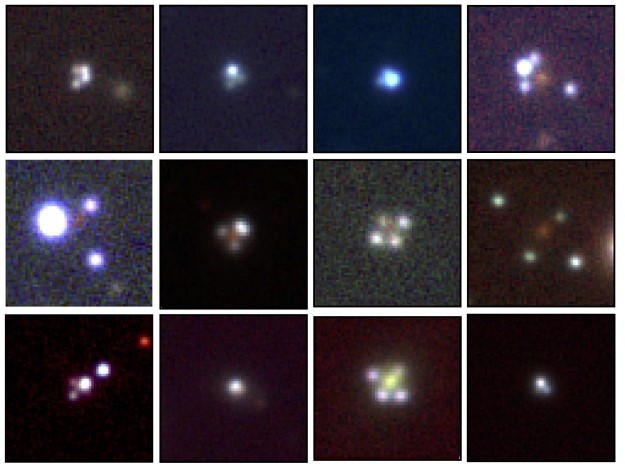Astronomers from the Gaia Gravitational Lenses Group have found 12 gravitationally lensed quasars, each showing four unique quadruple images, called Einstein's cross, using the European Space Agency's Gaia mission and NASA's Wide-Field Infrared Survey Explorer (WISE). The finding could assist in better understanding the rate of expansion of the universe and potentially solve mysteries concerning dark matter.
In the study (Gaia GraL: Gaia DR2 Gravitational Lens Systems. VI. Spectroscopic Confirmation and Modeling of Quadruply-Imaged Lensed Quasars), the scientists combined several telescope observations to confirm the results. Only 50 quadruple quasars have been pinpointed since the first image of such quasars was taken in 1985. The newly discovered quasars added to the total confirmed Einstein crosses by 25 percent.
12 rare Einstein crosses have been discovered with @ESAGaia!
— ESA Science (@esascience) April 7, 2021
The light of these #quasars is so strongly deflected by foreground galaxies that they are each visible as four distinct images.
They can help determine the expansion rate of the Universe 👉
https://t.co/IVeDsQ7Fr7 pic.twitter.com/R3uWM5NQNS
What are Quasars?
Quasars refer to the faraway galaxies with highly luminous nuclei. They are made up of black holes that are several billion times bigger than our Sun and encircled by thick gaseous matter. Quasar sightings are primarily utilized to study dark matter in finding out the evolution of galaxies and to grasp the universe's rate of expansion, which is gauged using the Hubble-Lemaitre constant.
More discoveries of quasar quadruples can help accurately calculating the Hubble-Lemaitre constant, thereby knowing at what rate our universe is expanding, researchers said.
The scientists had analyzed a large volume of images that were captured using various telescopes while the ESA did its sky surveys in the last 18 months. Augmented intelligence and Big Data were used to validate this finding.
Why Do We See Quadruple Quasars?
Gravity would have immense objects like galaxies and their emissions to bend over time and space. Likewise, a quadruple quasar's emissions are said to go through such deflection that leads to "natural" lenses. Such deflection results from the existence of several galaxies acting as barriers between a source and Earth, eventually splitting into four images.

Called gravitational lensing, this view of the quasars has been observed many times previously. There are times quasars are lensed into two similar images, and rarely, into four.
"We needed to confirm that the four closely packed images were not a pure chance alignment of four independent sources, but really four images of a single, distant source, lensed by an intervening galaxy," study co-author Christine Ducourant of the University of Bordeaux in France said in a statement.
The nearest quadruple quasar was situated 5,000 megaparsecs away.
How Do We Confirm If They Are Indeed Quadruple Quasars?
Astronomers utilized WISE data to discover new quasar bets and then use Gaia's sharp resolution to pinpoint which among the WISE candidates seem to associate with potential quadruple imaged quasars.
Machine learning tools are then applied to select which among the quasar bets were most probably quasars, and not just different stars staying near to each other.
Follow-up observations confirmed the objects as quadruple imaged quasars billions of light-years away.
RELATED ARTICLE : Astronomers Detected Newest Batch Of 16 Quasars, Exhibit High Redshift
Check out more news and information on Astronomy on Science Times.












